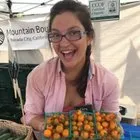Marketing Your CSA (Part II): The Price Is Right
Photo credit to Anchor Run Farm
This is the second of a four-part series on marketing your CSA, loosely following the four P’s:
product, price, placement and promotion.
When pricing your community supported agriculture shares, where do you begin?
Having never started my own CSA, this seemed like an overwhelmingly complex question -- one I had
long been curious about. Do you determine the retail value of the share by researching area prices
for the crops you will grow? Do you start with your overall cost of production, look at how much you
need (or want) to make, and work backwards? Or is there some other perfect formula for profitable
farming that magically reveals itself to you when you become a CSA farmer? After a bit of this kind
of pondering, I decided to reach out to my extended ag community to gather information.
After hearing from a few farmers, it turns out that starting with retail value or working backwards
from cost of production are both common approaches. (Sadly the jury is still out on the existence of
a magic formula… but I imagine a prayer to the CSA gods, or the summer-solstice sacrifice of your
most perfect, twelve-pound heirloom tomato, couldn’t hurt.)
However you go about it, you’d do well to look at prices for CSA shares in your area. It should
come as no surprise that this, in my informal survey, was the most oft-cited factor, with nearly
three quarters of respondents indicating prices for CSA’s nearby as an important consideration.
Adjustments up or down based on whether your CSA will offer more weeks, greater diversity, smaller
quantity but of rare specialty crops, organic certification -- or on any of the factors above --
could bring you to a good rough range.
Whatever your starting point, there are a number of factors that could impact your pricing
decisions. Some of these could include:
-
the number of shares you estimate having in your first season
-
the average income of your target members / what you think the market will bear
-
whether you are a new CSA farm with systems to improve and kinks to work out, OR
-
whether you are an existing farm with good brand recognition and the ability to reliably provide products of consistent quality
-
whether your CSA will include additional member benefits such as u-pick crops, discounts at farmers markets or member-only events that would add value to the share
-
whether you plan to offer a sliding-scale model or work-trade
This last factor -- whether to offer sliding-scale or alternative pricing options -- is a big one…
one that really throws open the door to a whole range of different models and approaches. Many
farmers feel strongly about making their CSA accessible to all income levels, and do this in a
variety of ways, from offering a range of payment levels or setting up a financial aid fund to
working a set number of lower-income shares into your regular share price.
Whatever number you close in on, remember that there’s a good chance you’ll want to adjust the
price (up or down) the following year. To decide whether to start high or low, I would suggest
considering the implications of each scenario. Why did your prices go up, or down? Imagine what that
conversation would look like with potential or returning customers.
For example, setting the price high works great if you get all the shares you’re looking for. If
not, you’ll end up lowering it to hit that number (or a slightly higher number due to the price
decrease). In my opinion, this approach comes with two risks. One, you could be sending a message
that your share isn’t really worth the price you originally set -- that the value of your shares is
negotiable. And two, folks who may have looked away after seeing the high price tag might not look
back again. Even though you’ve lowered the price, you may have already lost their attention. That
said, I hear this method does work for some farmers.
The other approach -- and the one that speaks more to me -- is that it’s better to slightly
undervalue your shares initially, and to then raise your prices. Of the 25 farmers who responded to
my informal survey, two thirds increased their prices. (The other one third kept their CSA share
prices the same.) Reasons for this increase ranged from those as universal as increased overhead
costs and adjustment for inflation, to beginning CSA farmers undervaluing shares initially or
established CSA farmers documenting the actual value of the share as significantly exceeding current
cost. This approach does require you to feel confident in explaining and standing behind your price
increase, and in your having attained strong member support and satisfaction in the season
prior.
If you liked this article, and want to see more like it, enter your email in the subscribe box to the top-right of this page and we'll send you new blog articles as we publish them.

After graduating from UCSC's
Center for Agroecology and Sustainable Food Systems, Lauren Alexandra Kaplan spent a season at
an organic CSA farm in California before returning east to farm in the Hudson Valley. Prior to
pursuing farming full time, she worked in book publishing and helped to launch an urban farm in
NYC. Alexandra is an avid salsa dancer and maker of jams, pickles, and kraut.